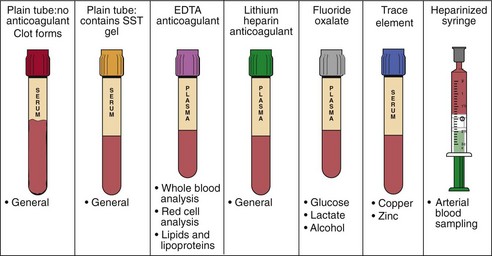The use of the laboratory
Specimen collection
A variety of specimens are used in biochemical analysis and these are shown in Table 2.1.
Blood specimens
If blood is collected into a plain tube and allowed to clot, after centrifugation a serum specimen is obtained (Fig 2.1). For many biochemical analyses this will be the specimen recommended. In other cases, especially when the analyte in question is unstable and speed is necessary to obtain a specimen that can be frozen quickly, the blood is collected into a tube containing an anticoagulant such as heparin. When centrifuged, the supernatant is called plasma, which is almost identical to the cell-free fraction of blood but contains the anticoagulant as well.

Fig 2.1 Blood specimen tubes for specific biochemical tests.












